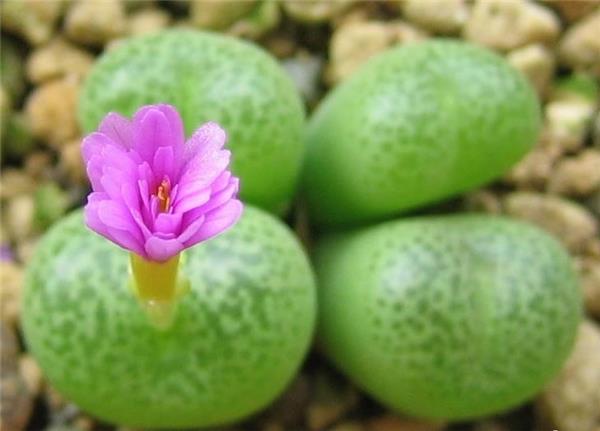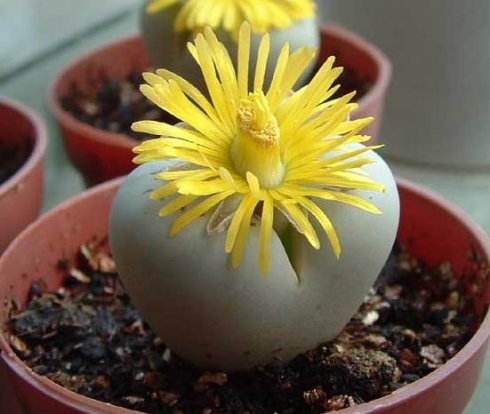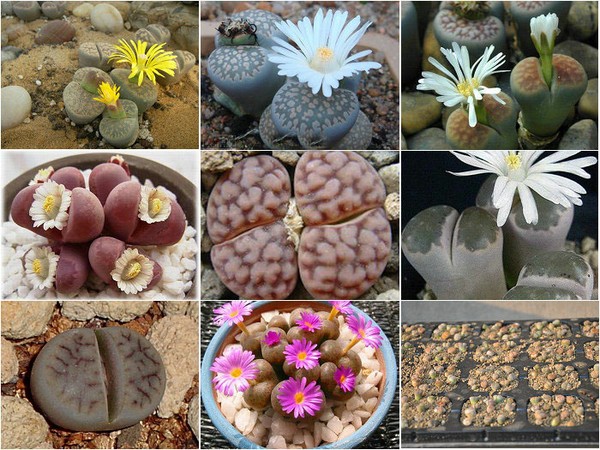Is the raw stone flower poisonous? how to raise the raw stone flower well
Stone flowers small plants are often used in bonsai flowers, so raw stone flowers are poisonous. This problem has perplexed many flower friends, many flower friends like raw stone flowers, but afraid that raw stone flowers are poisonous and dare not raise them at home. So are raw stone flowers really poisonous? next we will tell you whether raw stone flowers are really poisonous.
Is the stone flower poisonous?
I can definitely tell you that raw stone flower is not poisonous, because I have tried it. It is not only non-toxic but also tasteless, just contains more water. As long as the wetting degree of the plant material is appropriate, the fresh stone flower seeds can germinate within a week after planting, while the too old seeds have a very low germination rate. As for how long it takes to grow up and blossom, it depends on the level of your maintenance. Master health stone flowers bloom within two years.

Photosynthesis of Lithocarpus formosanus
At night, CO2 in the atmosphere enters the cytoplasm through stomata and is catalyzed by phosphoenolpyruvate (PEP) carboxylase to combine with PEP to form oxaloacetic acid, which is then reduced to malic acid by malate dehydrogenase and stored in vacuoles. Its concentration can reach 100mm per liter. It is an active process for malic acid to enter the vacuole from the cytoplasm through the tonoplast, while it is a passive process to return from the vacuole to the cytoplasm. During the day, malic acid is released from the vacuole and decarboxylated to form CO2 and C3 compounds (see tetra-carbon plants). There are two kinds of decarboxylase that can catalyze this reaction. In some plants, NADP (coenzyme Ⅱ)-or NAD (coenzyme Ⅰ)-malic enzyme catalyzes oxidative decarboxylation to form CO2 and pyruvate, while in other plants, PEP carboxykinase catalyzes the formation of oxaloacetic acid and decarboxylation to produce CO2 and PEP. After CO2 is produced, it is re-fixed by photosynthetic carbon cycle, and finally starch and other sugars are formed. In low light, especially when the temperature is high, some CO2 will be released into the atmosphere.

How to raise stone flowers
Stone flowers like warm climate in winter and cool in summer, warm, dry and sunny environment. Be afraid of low temperature and avoid bright light. There is plenty of sunshine and the optimum temperature for growth is 10-30 ℃. It is suitable to grow in loose neutral sandy loam. Remember to reduce moisture properly in winter and summer to help you molt.
Like sunshine, the suitable temperature for growth is 20 ℃-24 ℃, and it should be cultured on the southward balcony or windowsill in spring and autumn, which is the prosperous period of its growth, and should be watered every 3 seconds every 5 days to promote growth and flowering. The growth law of stone flower is that it begins to grow from March to April, pauses in the high temperature season, enters the summer dormancy period, continues to grow and blossom after cool autumn, and enters the overwintering period after the flower blossoms.
Stone flowers are native to the extremely dry desert gravel areas of Cape, South Africa, with annual rainfall below 250mm, with an average temperature of 10 ℃ in winter and 25 ℃ in summer. Dormant in the dry season, the sphere gradually shrinks and buries into the soil, leaving only the top surface exposed to the surface like gravel. This kind of "mimicry" can prevent birds and animals from swallowing.

In order to adapt to the environment, it evolved from dicotyledons to succulent typical bulbous plants, relying on water storage tissue in the cortex to preserve a rare bit of water. The top is slightly flat, with a gap in the middle from which 3-4-year-old plants produce yellow, white or pink flowers in autumn.
When the raw stone flower is dormant or semi-dormant at high temperature in summer, it should be slightly shaded and watered with restraint.
Stone flowers are native to bedrock fissures or gravel soil in arid areas of southern Africa and southwest Africa. In the dry season, the plant shrinks and is buried in gravel sand or only the top surface of the plant is exposed, and light enters the body only from the transparent top surface (window). When the rainy season comes, it quickly returns to its original plant type and grows up. Therefore, if it does not grow and blossom in the rainy season, it is difficult to find stone flowers in the gravel of the country of origin. this is its self-protective nature to prevent predation by small animals, which is called "mimicrp". The genus name Lithops is composed of Lithos (stone) and ops (appearance) in Greek. The earliest Chinese name is "Shi Guan" (see Yang's Horticultural Classic), and now the Chinese name commonly used in China is "raw stone flower".
Stone flowers like sunshine, and the suitable temperature for growth is 20 ℃-24 ℃. They should be cultured on the southward balcony or windowsill in spring and autumn, which is the peak period of their growth, and should be watered every 3 times every 5 days to promote growth and flowering. The growth law of stone flower is that it begins to grow from March to April, pauses in the high temperature season, enters the summer dormancy period, continues to grow and blossom after cool autumn, and enters the overwintering period after the flower blossoms. Sex like sunshine, high temperature resistance, but need good ventilation, otherwise it is easy to rot. Avoid waterlogging. The winter temperature should be kept at 8: 10 ℃.

Originally from the extremely dry and rainless desert gravel zone of Cape, South Africa, the annual rainfall is below 250mm, the average temperature in winter is IO ℃, and the average temperature in summer is 20 Mel 25 ℃. Dormant in the dry season, the sphere gradually shrinks and buries into the soil, leaving only the top surface exposed to the surface like gravel. This kind of "mimicry" can prevent birds and animals from swallowing. In order to adapt to the environment, it evolved from dicotyledons to succulent typical bulbous plants, relying on water storage tissue in the cortex to preserve a rare bit of water. Its top face is called "window". There is chlorophyll in the window for photosynthesis. The top is slightly flat, with a gap in the middle from which 3-4-year-old plants produce yellow, white or pink flowers in autumn.
In the wild, stone flowers do not bloom until the rainy season begins. Under cultivation conditions, most varieties can resume watering in early and middle August. Often an effective soil moisture can promote the stone flower to enter the growth stage. Because the stone flower has a main root, it is more advantageous to water thoroughly than thin water in autumn. It's important to dry the soil during the watering interval: when you water it again, the soil can't be wet. The soil needs to be well drained and dried quickly. Airtight soil can cause plants to rot. Watering should be reduced regularly after flowering, and water should be cut off in late September to dry the soil to prepare for the coming of winter.
The growth of stone flowers in the field is restored according to Rain Water, and it can be gradually watered in late August under cultivation conditions. Watering during this period should be from small to large, to be thoroughly watered, and to keep the soil completely dry once during two watering times.
In winter, stone flowers are still growing, the new body will gradually grow to a certain size, and the old leaves outside will shrink. No matter how wrinkled the plants are, they don't need water in winter to keep the soil dry. In fact, the new leaves absorb water and nutrients from the old ones, so don't cut off the old ones.
The new leaves of stone flowers absorb the water and nutrients stored in the old leaves until the old leaves become a paper shell. This kind of paper shell can be easily removed. At this time, the plant enters the spring growth, and can be safely watered to promote plant growth. A small amount of water should be watered at first, and then gradually increased, and the water can be watered thoroughly in the middle of spring. Of course, make sure that the soil is dry between two watering times. When hot summer comes, the amount of water needs to be reduced to prepare plants for summer dormancy.
Originally from the extremely dry and rainless desert gravel zone of Cape, South Africa, the annual rainfall is below 250mm, the average temperature in winter is IO ℃, and the average temperature in summer is 20 Mel 25 ℃. Dormant in the dry season, the sphere gradually shrinks and buries into the soil, leaving only the top surface exposed to the surface like gravel. This kind of "mimicry" can prevent birds and animals from swallowing. In order to adapt to the environment, it evolved from dicotyledons to succulent typical bulbous plants, relying on water storage tissue in the cortex to preserve a rare bit of water. Its top face is called "window". There is chlorophyll in the window for photosynthesis. The top is slightly flat, with a gap in the middle from which 3-4-year-old plants produce yellow, white or pink flowers in autumn.
In the wild, stone flowers do not bloom until the rainy season begins. Under cultivation conditions, most varieties can resume watering in early and middle August. Often an effective soil moisture can promote the stone flower to enter the growth stage. Because the stone flower has a main root, it is more advantageous to water thoroughly than thin water in autumn. It's important to dry the soil during the watering interval: when you water it again, the soil can't be wet. The soil needs to be well drained and dried quickly. Airtight soil can cause plants to rot. Watering should be reduced regularly after flowering, and water should be cut off in late September to dry the soil to prepare for the coming of winter.
The growth of stone flowers in the field is restored according to Rain Water, and it can be gradually watered in late August under cultivation conditions. The obvious sign is to blossom. At the same time, its new leaves began to breed. Watering during this period should be from small to large, to be thoroughly watered, and to keep the soil completely dry once during two watering times.
In winter, stone flowers are still growing, the new body will gradually grow to a certain size, and the old leaves outside will shrink. No matter how wrinkled the plants are, they don't need water in winter to keep the soil dry. In fact, the new leaves absorb water and nutrients from the old ones, so don't cut off the old ones.
The new leaves of stone flowers absorb the water and nutrients stored in the old leaves until the old leaves become a paper shell. This kind of paper shell can be easily removed. At this time, the plant enters the spring growth, and can be safely watered to promote plant growth. A small amount of water should be watered at first, and then gradually increased, and the water can be watered thoroughly in the middle of spring. Of course, make sure that the soil is dry between two watering times. When hot summer comes, the amount of water needs to be reduced to prepare plants for summer dormancy.
- Prev

[is the flower of crab claw orchid poisonous? is the flower of crab claw orchid poisonous?
[is the flower of crab claw orchid poisonous? is the flower of crab claw orchid poisonous?
- Next

[plain sailing maintenance] how to maintain smooth sailing
[plain sailing maintenance] how to maintain smooth sailing
Related
- Wuhan Hospital Iron Tree Blooming Result Was Instantly Frightened by the Gardener Master
- Which variety of camellia is the most fragrant and best? Which one do you like best?
- What is the small blue coat, the breeding methods and matters needing attention of the succulent plant
- Dormancy time and maintenance management of succulent plants during dormancy
- Minas succulent how to raise, Minas succulent plant pictures
- What are the varieties of winter succulent plants
- How to raise succulent plants in twelve rolls? let's take a look at some experience of breeding twelve rolls.
- Attention should be paid to water control for succulent plants during dormant period (winter and summer)
- Watering experience of twelve rolls of succulent plants
- Techniques for fertilizing succulent plants. An article will let you know how to fertilize succulent plants.

